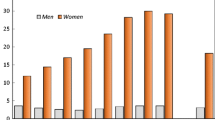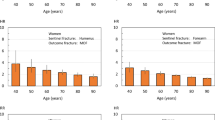Abstract:
Symptomatic fractures are a significant problem in terms of both morbidity and financial cost. Marked variation in both total and site-specific fracture incidence has been documented internationally but there is limited within-country data. This prospective population-based study documented the incidence of all symptomatic fractures occurring from July 1, 1997 to June 30, 1999 in adults ≥50 years of age resident in Southern Tasmania (total population ≥50 years: 64 688). Fractures were ascertained by reviewing reports from all the radiology providers within the area. There were 701 fractures in men and 1309 fractures in women. The corresponding fracture incidence in men and women was 1248 and 1916 per 100 000 person-years, respectively. Residual lifetime fracture risk in a person aged 50 years was 27% for men and 44% for women with fractures other than hip fractures constituting the majority of symptomatic fracture events. These fracture risk estimates remained remarkably constant with increasing age. In comparison to Geelong, there were significantly lower hip fracture rates (males: RR 0.59, 95% CI 0.45–0.76; females: RR 0.61, 95% CI 0.53–0.71) but significantly higher distal forearm fractures (males: RR 1.87, 95% CI 1.10–3.78; females: RR 1.31, 95% CI 1.11–1.55) and total fractures in men (RR 1.31, 95% CI 1.17–1.46) but not women (RR 1.05, 95% CI 0.98–1.13). In contrast, Southern Tasmania had lower age-standardized rates of all fractures compared with Dubbo (RR 0.28–0.79). In conclusion, this study provides compelling evidence that fracture incidence varies between different geographic sites within the same country, which has important implications for health planning. In addition, the combination of high residual fracture risk and short life expectancy in elderly subjects suggests fracture prevention will be most cost-effective in later life.
Similar content being viewed by others
Author information
Authors and Affiliations
Additional information
Received: 27 April 2000 / Accepted: 16 August 2000
Rights and permissions
About this article
Cite this article
Cooley, H., Jones, G. A Population-Based Study of Fracture Incidence in Southern Tasmania: Lifetime Fracture Risk and Evidence for Geographic Variations within the Same Country . Osteoporos Int 12, 124–130 (2001). https://doi.org/10.1007/s001980170144
Issue Date:
DOI: https://doi.org/10.1007/s001980170144




